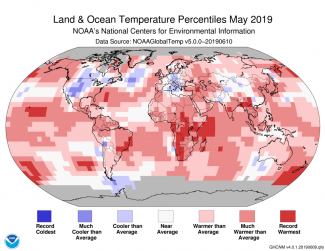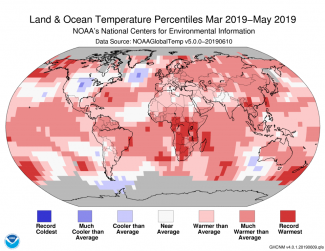Fourth warmest May for globe, record-low Antarctic sea ice extent

The global land and ocean surface temperature departure from average for May 2019 was the fourth highest for the month of May in the 140-year NOAA global temperature dataset record, which dates back to 1880. The March–May temperature was second highest, and the January–May temperature was the third highest such period on record.
This monthly summary, developed by scientists at NOAA’s National Centers for Environmental Information, is part of the suite of climate services NOAA provides to government, business, academia and the public to support informed decision-making.
May 2019 Temperature
-
The May temperature across global land and ocean surfaces was 1.53°F above the 20th century average of 58.6°F and was the fourth highest for May in the 1880–2019 record. The last five years (2015–2019) are the five warmest Mays on record, with May 2016 the warmest with a global land and ocean temperature at 1.67°F above average.
-
Record-warm May temperature departures from average were present across parts of the southern half of Africa, western Indian Ocean, New Zealand and its surrounding southern ocean, as well as parts of Asia, South America and the Atlantic and Pacific oceans. No land or ocean areas had record-cold May temperatures.
-
-
The May globally averaged land surface temperature was 2.09°F above the 20th century average of 52.0°F. This value was the eighth highest May land temperature in the 140-year record.
-
The most notable warm land surface temperature departures from average during May 2019 were present across parts of northern Canada and Antarctica, where temperatures were at least 7.2°F above average. The most notable cool temperature departures from average were present across much of the western half of the contiguous U.S., central and southeastern Canada and northern and central Europe. Temperature departures for these locations were 3.6°F below average or cooler.
-
The cooler-than-average conditions across parts of the Northern Hemisphere land contributed to its least-warm May temperature departure from average since 2011. Meanwhile, the Southern Hemisphere land temperature departure from average tied with 2017 as the highest May temperature since records began in 1880.
-
The Hawaiian region had its warmest May on record. South America and Africa had a May temperature that ranked among the three warmest Mays on record. Meanwhile, Europe and North America had their coolest May temperature since 2004 and 2011, respectively. Also, the Caribbean region had its coolest May since 2009.
-
-
The May globally averaged sea surface temperature was 1.31°F above the 20th century monthly average of 61.3°F, tying with 2015 as the second-highest global ocean temperature for May in the record, behind 2016 (+1.44°F). The five warmest May global ocean temperatures have occurred since 2014.
Sea Ice and Snow Cover
-
The May average Arctic sea ice extent was the second smallest in the 41-year record at 436,000 square miles (8.5 percent) below the 1981–2010 average, according to an analysis by the National Snow and Ice Data Center using data from NOAA and NASA. The record smallest May Arctic sea ice extent was set in 2016 at 10.3% below average. During May 2019, rapid sea ice loss was observed in the Bering Sea and southern Chukchi Sea. The Bering Sea had near-record low sea ice extent for the fourth consecutive month.
-
Antarctic sea ice extent during May was 510,000 square miles (13.0 percent) below the 1981–2010 average. This was the smallest May extent on record. According to the National Snow and Ice Data Center, the below-average sea ice extent in the eastern Weddell Sea and northern Amundsen Sea contributed to the overall record-low May sea ice extent.
-
According to data from NOAA and analyzed by the Rutgers Global Snow Lab, the Northern Hemisphere snow cover extent during May was 760,000 square miles below the 1981–2010 average. This was the 10th smallest snow cover extent in the 53-year record. The North American and Eurasian snow cover extents were also below average, both ranking as the eighth smallest on record.
Seasonal (March–May 2019)
-
The March–May 2019 average temperature across global land and ocean surfaces was 1.73°F above the 20th century average of 56.7°F and the second highest for March–May in the 1880–2019 record. March–May 2016 was the warmest on record at 2.00°F above average. The five warmest March–May periods have occurred since 2015. The global land and ocean surface temperature for the three-month season has increased at an average rate of 0.14°F per decade since 1880; however, the average rate of increase is more than twice as great (0.32°F per decade) since 1981.
-
Record-warm temperatures during the three-month period were present across parts of Alaska and western Canada, the Barents Sea, New Zealand and its surrounding southern ocean, the southern half of Africa, and across parts of South America, western Indian Ocean and the Atlantic and Pacific oceans. No land or ocean areas had record-cold temperatures during March–May 2019.
-
-
The globally averaged land surface temperature for March–May was also the second highest on record at 2.81°F above the 20th century average of 46.4°F. This value falls behind the record year 2016 by 0.61°F.
-
The most notable warmer-than-normal land surface temperature departures from average during March–May 2019 were present across much of the high latitudes in the Northern Hemisphere, specifically across much of Alaska, northwestern Canada and north-central and Far East Russia. The temperature departures from average in these locations were at least +5.4°F. The most notable cooler-than-average conditions were limited to the central contiguous U.S., where temperatures were at least 1.8°F below average or cooler. No land or ocean areas had record cold March–May temperatures.
-
The Southern Hemisphere land temperature departure from average during the three-month season was the highest for March–May in the 140-year record at 2.34°F above average.The Northern Hemisphere’s land had its third highest March–May period on record.
-
Regionally, Africa, Asia and Oceania had their third highest March–May temperature departure from average on record. South America had its fourth warmest March–May on record, and Europe and the Hawaiian region had their ninth warmest on record.
-
-
The March–May globally averaged sea surface temperature was 1.33°F above the 20th century average of 61.0°F — also the second highest for March–May on record, trailing behind 2016 (+1.48°F).
Year-to-date (January–May 2019)
-
The year-to-date temperature across global land and ocean surfaces was 1.67°F above the 20th century average of 55.5°F — the third highest for January–May in the 140-year record.
-
The year-to-date period was characterized by warmer-than-average conditions across much of the globe’s land and ocean surface. Notable warm temperatures were present across much of Alaska, northwestern Canada and central and Far East Russia, where temperatures were at least 5.4°F above average. The most notable cooler-than-average temperatures were present across much of the contiguous U.S. and the southern half of Canada.
-
-
The year-to-date globally averaged land surface temperature was 2.68°F above the 20th century average of 42.8°F. This value was also the third highest for January–May in the record.
-
Record-warm temperatures during the year-to-date period were present across parts of the southern half of Africa, Australia, southeastern Brazil, northern North America, Asia, as well as across parts of the southern oceans, and the Barents Sea and parts of the North Pacific Ocean. No land or ocean areas had record-cold temperatures during January–May 2019.
-
Regionally, South America, Europe, Africa, Asia and Oceania had a January–May 2019 temperature departure from average that ranked among the 10 highest such periods on record. Of note, Oceania had its second warmest January–May on record, behind 2016.
-
-
The year-to-date globally averaged sea surface temperature was 1.30°F above the 20th century average of 60.8°F. This was also the third highest for January–May in the 1880–2019 record.
The Global Report for May 2019 utilizes the newly released NOAAGlobalTemp dataset version 5 from NOAA NCEI.








